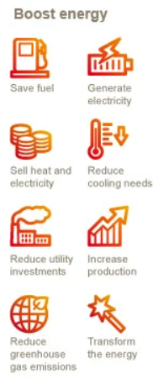What is waste heat?
Waste heat is energy that is wasted to the environment and is not taken into use.
What is waste heat recovery?
The reuse of heat energy that would otherwise be wasted or will be released into the atmosphere, is known as “Waste Heat Recovery”
What are the Examples of Waste Heat Recovery?
- Turbo Charged cars
- Economizers in Boilers
- Air Preheaters
- Regenerators
- Heat Exchangers
- Absorption Chiller
- Steam Thermocompression
What are the uses of Waste Heat Recovery in Boilers?
One of the most basic types of waste heat recovery are stack economizers, which are frequently used to heat water in Boilers.
Heat energy from the gas released during the heating process in the boiler flue gas chamber is used by boiler stack economizers to heat the water that goes into the boiler, which lowers the energy needed to produce steam.
The US Department of Energy claims that installing a boiler feed water economizer can increase a boiler’s thermal efficiency and decrease fuel usage by 5% to 10%.

These boilers work by drawing heat from a hot fluid, usually a gas, that is created as a byproduct of a chemical reaction but has no inherent value as a chemical or that is the exhaust from a gas turbine or internal combustion engine.
Boilers for heat recovery are frequently used in high temperature operations like the production of glass and steel
What are the uses of Waste Heat Recovery in Boilers?
The ideal option for any industry is Solarkaz waste heat recovery boiler systems. Waste heat systems allow heat that is released into the atmosphere to be recovered and used as extra energy for another operation. The need for more efficient and economical energy use grows as energy prices are rising, all over the world.
To ensure long-term improvement of plant performance, quality, and productivity, Solarkaz proudly displays its knowledge in goods and services, amassed in this field over time, and offers a wide range of customized and standardized solutions for waste heat recovery. Every waste heat recovery system is specially developed to meet a particular need.
Waste heat recovery systems offer a wide range of applications and advantages in industrial settings, and one effective method for heat exchange is the shell and tube heat exchanger. By understanding the principles of shell and tube heat exchangers, we can explore their practical examples and further appreciate their role in maximizing energy efficiency through waste heat recovery.

What are the Advantages of using Waste Heat Recovery Boilers?
- Environment hence using waste heat recovery keeps waste gases at low temperatures
- Highest efficiency gain due to integrated economizers
- Utilities (requiring heat energy) can be utilized nearby these boilers
- Less use of fuel hence increasing the overall efficiency of the boiler
- Highly reliable in operation and robust in construction
- Quick payback returns are achieved
- Eco-friendlyEnergy which was earlier wasted is utilized.

High Return on Investment
The payback period for waste heat recovery boilers is less than 2 year, making them an excellent investment opportunity.
Waste Heat Recovery Boiler Design
According to the needs of the plant, waste heat recovery boilers are made to recover heat from waste flue gases from the exhaust, furnace exhaust, kiln exhaust, incinerator exhaust, etc. to produce steam or hot water.
4 basic parameters shall be considered for designing the waste heat recovery system in Boilers, which are:
- Type of fuel and its composition
- Amount of flue gases leaving the exhaust system
- The temperature of flue gases at exhaust
- Utilization of waste heat
Water tube boilers that use the medium to high-temperature exhaust gases to generate steam include waste heat boilers like the two-pass boiler. There are several different capacities for waste heat boilers, allowing for high flows of gas intakes.
Auxiliary burners or an afterburner can be installed to increase steam output when waste heat is insufficient to produce the appropriate levels of steam. Power generation or process heating are two uses for steam. An external superheater must be added to the system to produce superheated steam.
Do you want to order a WHR boiler? Contact us to get a quote today!


